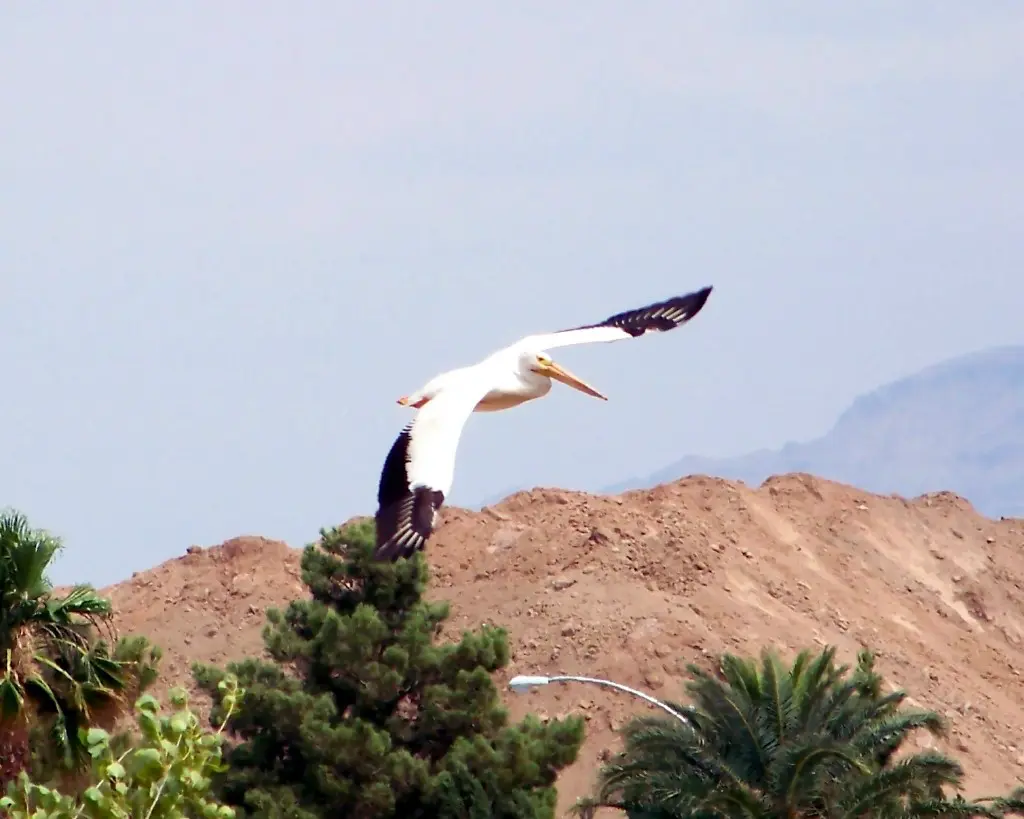The American White Pelican

WHAT WETLANDS PARK MIGRANT HAS THE BIGGEST BEAK?
Though we often think of pelicans as purely marine birds, the American birds nest in breeding colonies on inland islands, mostly in western North America, and several of them in the Great Basin. They forage for the fish they eat in the shallow, sheltered waters of lakes, marshes, and lagoons, and may commute up to 200 miles round trip to hunt. One of the largest colonies is on Anaho Island in Pyramid Lake, north of Reno and Fernley, Nevada, where up to 6,500 pairs of the pelicans nested in some years. Fossil pelican breeding colonies found on the shores of Pleistocene Lakes like Lahontan and Bonneville show that the birds have nested in these western colonies for thousands of years.
Once their families are raised, white pelicans migrate to coastal areas from central California to southern Mexico, as well as the Gulf Coast, to spend the winter. This annual migration pattern means we have to stay alert if we want to see them as they pass through the Park heading north in February and March, and south in October and November. They are definitely worth packing a lunch and your binoculars to go see.
“A wonderful bird is a pelican. His beak will hold more than his belly can,” says Dixon Lanier Merritt in a limerick he published in the early 1900’s. Amazingly, the limerick is correct – the eighteen and a half inch long hooked beak of a pelican (longest of any North American bird) can hold around three gallons in its large pouch, while the bird’s stomach holds only about a gallon.
Feeding white pelicans swim in groups, herding the small fish they eat into shallow water where they plunge their beaks into the water like dip nets to scoop up the fish along with the surrounding water. The birds squeeze out the excess water before they swallow their food. Occasionally a bird will catch a fish between its two mandibles. At Pyramid Lake the pelicans feed mainly on tui-ui chubs and carp, but they will take any fish of the correct size, and have also been seen eating occasional salamanders and crayfish.
If you pay attention to the “beak-action” while watching a group of pelicans feed, you may notice a keel-like “horn” toward the middle of the top of the beak on both males and females. This growth is made of the same material as human fingernails. It develops at the beginning of breeding season each year, perhaps as a breeding ornament, and falls off about the time the parents begin to incubate their eggs.
The Park provides an important stopover rest for these majestic migrants. Even more important to their continued existence are safe ground-nesting areas and shallow water fishing grounds. In Nevada, ensuring the protection of breeding areas like Pyramid Lake’s Ahaho Island and feeding resources like Washoe Lake, the Humboldt River Sink, and Walker Lake will provide habitat to help these enormous, and amazing, birds survive for viewing far into our future.
– By Chris Leavitt, President; photo from Park archives.
Please enjoy these YouTube videos!
American White Pelicans Herding Fish: NARRATED
Squadron of American White Pelicans (Pelecanus erythrorhychos)
Pyramid Lake Pelicans
